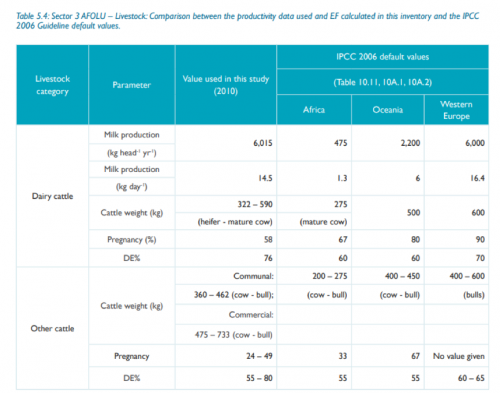Keywords: QA/QC | verification
What data needs were addressed? Verification of country-specific emission factors.
Why was the data needed? When South Africa first developed country-specific emission factors, Australian models of enteric fermentation were adopted, because conditions in Australia and South Africa are similar. Emission factors for South African livestock were developed by Du Toit et al. (2013a, 2013b, 2013c, 2013d) using Australian models for estimating enteric fermentation from ruminants, pseudo-ruminants and. The emission factors were estimated for the year 2010. The resulting emission factors were significantly different from those recommended by the IPCC for the African continent. Therefore, a method to compare emission factors and justify the choice of emission factor was needed.
Methods used: comparison with other emission factors.
How was the data need addressed? South Africa’s National Inventory Report (2014) compared the estimated emission factors with IPCC default values for Africa, Oceania and Western Europe and explored the underlying productivity data used to derive the IPCC default emission factors.
Comparison of emission factors showed that South Africa’s country-specific EFs were in the same range as the defaults for Oceania and Western Europe, but were not similar to defaults for Africa. This is explained by the productivity data. Milk production in South Africa in 2010 was 14.5 kg per day, much higher than the assumed 1.3 kg per day given for Africa. Cattle weights were also much higher (333 590 kg, compared to 275 kg for Africa). Pregnancy and DE percentages were also higher than those used in the IPCC default values.

Resources
Du Toit CJL, Van Niekerk WA. 2013a. Direct methane and nitrous oxide emissions of South African dairy and beef cattle. South African Journal of Animal Science.
Du Toit CJL, Van Niekerk WA. 2013b. Direct methane and nitrous oxide emissions of monogastric livestock in South Africa. South African Journal of Animal Science.
Du Toit CJL, et al. 2013c. Direct greenhouse gas emissions of the game industry in South Africa. South African Journal of Animal Science.
Du Toit CJL, et al. 2013d. Direct greenhouse gas emissions of the South African small stock sectors. South African Journal of Animal Science.
Author: Andreas Wilkes, Values for development Ltd (2019)

